Our next stop: Mathare. When I first arrived in Nairobi, I mentioned to Stephanie (my Kiva field contact) wanting to visit the Kibera slums, home to more than a million residents. I told her about the incredible program started at UNC Chapel Hill, Carolina for Kibera, and Duke’s own involvement with the organization. “You want to see a slum,” she said, “don’t go to Kibera. Come to Mathare, where even Kenyans refuse to visit.”
Puzzled, I soon discovered what she meant. When I told my colleagues at KADET that I was spending Saturday afternoon in Mathare, I might as well have told them I was planning to jump off of a bridge. I’ve quickly learned that Mathare is notoriously the most dangerous slum in Kenya, and nearly all Kenyans have only seen it from the perimeter. It is also where several of Stephanie’s friends live, including her best friend, Austin, therefore granting us secure access to the slum.
We catch a purple matatu, complete with green seats and an orange vinyl ceiling, and arrive a few minutes later. Exiting the matatu, we cross the street and step onto a muddy rectangular clearing. There is a group of about 30 children running after a ball, and I realize we are actually crossing a soccer field. Three mini-collisions later (no injuries) and we arrive at the other side of the field, where Austin is standing. Three toddlers cling to his pant legs as Stephanie introduces me to her closest friend on the continent. Austin is the only coach, so he returns his focus to the game, and Stephanie uses this as an opportunity to tell me more about Austin and to give me a mini-tour of Mathare.
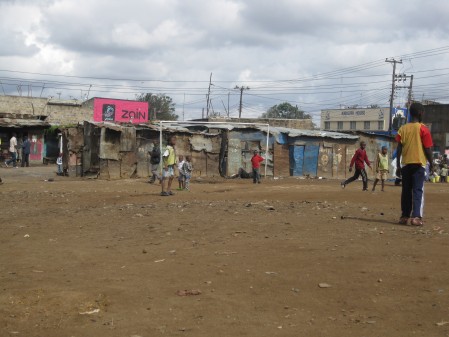
Mathare's soccer field
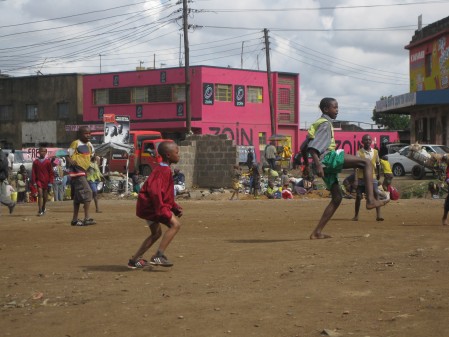
Austin's soccer players
Mathare is Kenya’s second largest informal settlement. One of the oldest and most densely populated slums in all of Africa, over 600,000 people live in this sprawling urban jungle just a few kilometers from Nairobi’s city center. Mathare exists in a valley that is the site of a former quarry. There are no trees, bushes or blades of grass. Most homes are one-room shacks made from corrugated tin sheets, each averaging three square meters in size and accommodating entire families. As we walk, we follow dozens of chickens, goats, and cows meandering through the narrow pathways.
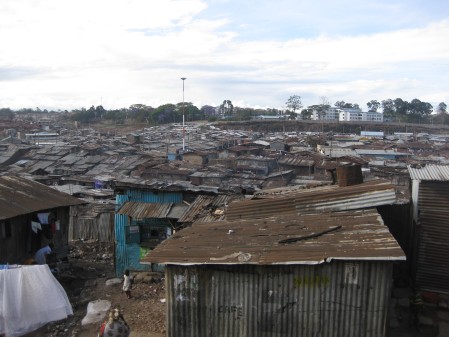
Ducking off the main road between corrugated tin shanties, we reach an outlook. The ramshackle collection of congested roofs reflects the sun in various shades of grays and browns.
It’s impossible to capture Mathare on film; the noises and smells are just as much a part of its identity. There is a pervading stench of human sewage. I remember seeing the musical Urinetown when I was a senior at Duke University. The show is about a backward community that starts charging its residents to use the toilets. The show is a comedy; in Mathare this is reality. The few toilets that exist cost 2-3 shillings to use. Most residents deposit their waste into plastic bags instead, throwing these nicknamed “flying toilets” into the alleys or dark Nairobi river which runs through the middle of the slum. The sharp scent of burning charcoal is also present throughout Mathare’s streets. Everyone cooks their meals in the alleyways, as their homes are too cramped, and the smell of githeri and sukuma wiki waft up and down the streets as the winds change.
Access to basic services is limited. Few have electricity, and for those that do, frequent blackouts last for long periods of time. Safe water is virtually nonexistent as groundwater sources are polluted by the contaminated Mathare River and excessive garbage. Adequate schools and healthcare are also major issues in Mathare. With little assistance from the Kenyan government, Mathare’s schools are overcrowded and many children do not attend school at all. HIV/AIDS and TB are highly prevalent, though it’s difficult to determine actual infection rates since few are tested.
Most of Mathare’s residents come to Nairobi from rural areas, where unreliable agriculture and high unemployment make life difficult, in search of a steady job and better life. With little money, these people come to one of the city’s many slums because housing is more affordable (rent is $5-$30 a month). However, life in the slums is not easy. Members of all of Kenya’s 42 ethnic groups call the slums home. Cultural traditions remain strong and ethnic segregation and violence are common. Gangs control much of the slum, and residents are forced to pay monthly protection fees to gang members. Frequent clashes between these gangs and the Kenyan police make the area a war zone at times.
Though some transplants manage to find the work they came in search of, Mathare boasts an unemployment rate of 75% or higher. Those that are able to find day labor, such as construction or washing clothes, make about $1-$1.50 per day. Some run small kiosks that sell vegetables or charcoal. For most, the business in which they are engaged does not provide a steady or reliable income, and they struggle to put food on the table while also trying to meet the expectation of sending money to extended family back in the rural area.
We circle back to Austin’s soccer game, where a water break is taking place. Three small girls, maybe 4 or 5 years old, lug large jugs of murky water to the thirsty players. While we watch Austin’s soccer teams gear up for the second half, Stephanie tells me about the amazing league he started. Austin was raised in the slum and rose to prominence as an incredible soccer player. He played professionally after college, even winning the Norway Cup. A knee injury took Austin out of the game, but ignited in him a focus on community and the desire to provide opportunity for the kids of Mathare. With no field available to him, Austin began clearing off a major garbage dump, one wheelbarrow at a time. After he had uncovered the ground beneath one small section, the inspired people of Mathare joined him in his efforts. Eventually the area was free to be used as a soccer field, and Austin has since built up an entire league for children of varying ages. Several of Austin’s female soccer players have obtained full scholarships to some of Kenya’s best private schools. Soccer has become as major source of pride and confidence for this community.
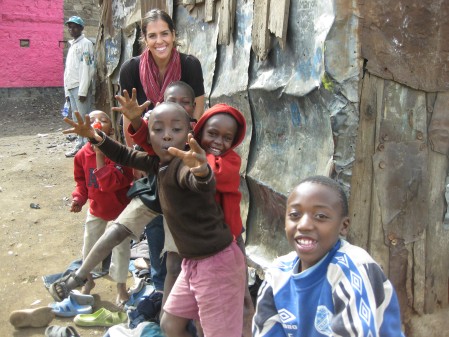
Sitting on the sidelines watching the soccer game with neighborhood kids
Watching the second half, I notice most of the children playing are not wearing shoes, and I wince as I watch one boy step on a shard of glass. His younger sister waddles over to where we are sitting, sucking on a discarded battery. The sound of children crying, ignored by adults, is persistent, and I bend down to pick up the child closest to me. His tears dry immediately; he just needed some love. Unfortunately, the parents here do not have the luxury of focusing on their children in the way we are accustomed to in the United States.
Stephanie again leads me away from the sidelines to visit a group of women with whom she works, helping them earn a fair living through a small business selling the sisal and cloth bags they make. Beneath its tin cover, Mathare teems with typical daily activities: women hanging laundry from ropes, food being sold in front of homes, and children wandering the streets, dressed in well worn, holed clothing or elegant dresses of American communions and Christmases past.
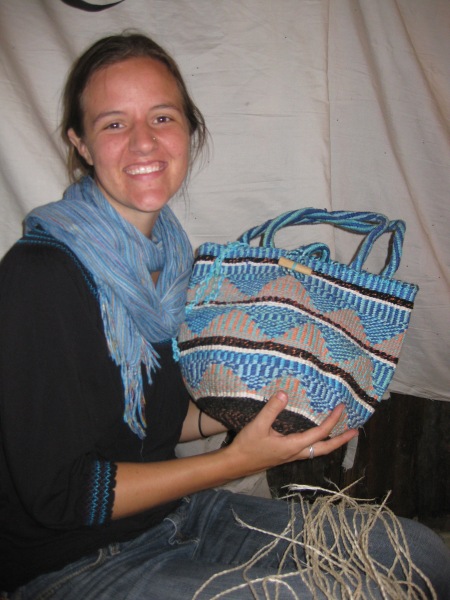
Stephanie, in Mama Florence's home, holding up one of her beautiful creations. For more information on the women's fair trade business, please visit: http://www.witethye.org
After being fed several bowls of githeri and pretending to drink the polluted water served to us by these women, Stephanie and I reunite with Austin to visit the school they are working together to build. A few years ago, Stephanie met the headmaster of a school that was considered a great success. However, all of the school’s funding was being spent on rent – for a crumbling, cramped, dangerous building. Realizing that the school needed its own secure space, Stephanie successfully fundraised $45,000 to buy a plot of land in Mathare. While progress is slow, it was amazing to stand on the completed foundation of the school. From the school’s grounds, we drank sodas and watched the sun set over the slum.
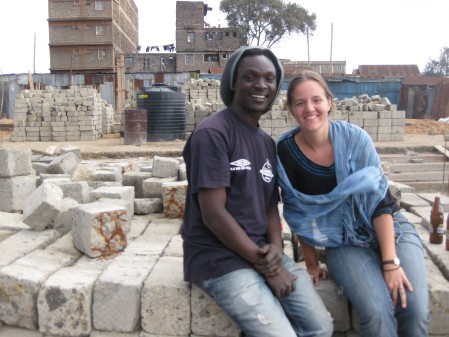
Austin and Stephanie, sitting on the foundation of the school they are working together to build
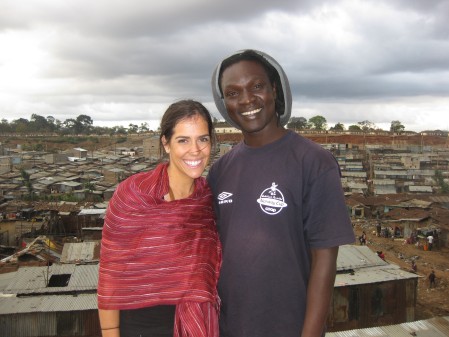
With Austin, overlooking Mathare at sunset. As we sipped our sodas from colorful straws, the temperature dropped significantly. By the time we finished our drinks, goosebumps covered our arms. Mathare faces both extreme heat during the day and icy temperatures at night.
Seeing Mathare for myself and being introduced to many with entrepreneurial spirits reinforced for me that positive change and improvements are realities, even in some of the toughest
neighborhoods. Despite the most challenging obstacles and hardships, I witnessed real signs of resiliency and progress.
That night Austin took Stephanie and me to a reggae club, where we danced the night away as the only mzungus in a crowded room of locals. In the wee hours of the morning, I climbed into a cab that took me back to the safety of my warm bed in the serene area of Upper Hill. Austin hugged me goodbye, got into a matatu and headed back to Mathare…
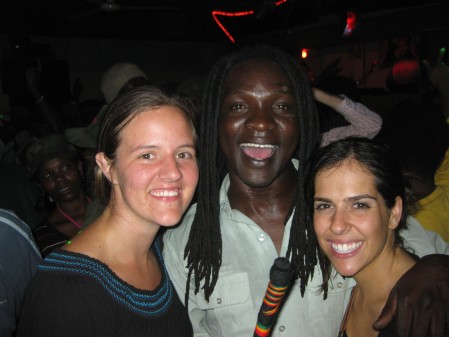
Steph, Austin and me at the reggae club "Monte Carlo"
On Monday morning, I asked my colleagues how many KADET clients live in Mathare. Disappointingly, the number is zero. Apparently, KADET used to have several borrowers in Mathare, but the inter-ethnic structure of borrower groups caused every single KADET group to fall apart in the midst of the post-election violence in 2008. The people of Mathare were also impacted by the scene that played out between the Mungiki gang and the police. When some individuals in Mathare started to resist the Mungiki influence, a spate of killings took hold. Several police tried to enter the slum to crack down on the brutality and were killed, their heads displayed on a central bridge as a strong warning to others. Enraged, the police conducted a massive sweep of the slum, inciting angry Mungiki members to use innocent individuals as shields against the rough hard-arm tactics of the police. Police beatings were common and arson became an even bigger issue. This eruption of violence was a very hard blow for those trying to make a living with small businesses. KADET borrowers (whose businesses included small kiosk shops, eateries, vegetable trading, and the sale of second-hand clothing) saw their businesses destroyed, and almost every single loan was written off as a loss for KADET.
While KADET no longer has any borrowers in Mathare, there are several clients living in the slums of Kibera and Korogocho. I have arranged to visit these individuals and will highlight these experiences in future posts.
**On a side note, I only took a few pictures while in Mathare. Though I want to bring awareness to the outside world, I struggle to balance this desire with the zoo-like feeling of photographing humanity living in stark conditions.
Hey Maia! I have been reading your blog and am amazed at some of the experiences you are getting. Great job on capturing your experience and making the public more aware. Good luck over there, and I look forward to reading more about your travels in Kenya!
– Roz
Thanks, Roz! I appreciate you taking the time to follow my experience here in Kenya. Please let me know if you have any specific questions.
Best regards,
Maia
Outstanding post and incredible insight. Thanks for sharing this amazing experience and also introducing us to Austin and his dynamic community.
Maia,
Hey, what an experience! When I was a small boy, my step brother used to live in Mathare, and I used to visit him, and stayed with him for several days. What you have described is very much what my experience was. Gosh, you even found your way to Monte Carlo – nice name isn’t it?
You ceratinly can find your way around Nrb now, on your own.
You know what? this almost made me shade a tear…….is persistent, and I bend down to pick up the child closest to me. His tears dry immediately; he just needed some love. Unfortunately, the parents here do not have the luxury of focusing on their children in the way we are accustomed to in the United States…….t is such a reality.
Mother Teresa once said “the worst form of poverty is that one of not being wanted” not exact words but the message is real – this type of lack of love is one of the worst types of poverty i can imagine.
Steve
Makanga,
Thank you very much for taking the time to read my blog. Your approval and comments mean a lot to me. I anticipated my audience being primarily those I know in the United States, and I’m thrilled that you (and other KADET staff) are reading. I’m especially grateful to know that you think I’ve given an accurate snapshot into parts of life here.
Regards,
Maia
Hi Maia, I am Amy Wagner’s mom (from HHS) and Amy sent me to your blog which is AMAZING. I work for a nonprofit in St Paul that distributes simple, culturally compatible devices which help impoverished, hungry people achieve food security. Check out our website at http://www.compatibletechnology.org and keep us in mind as you travel. We are currently working on a 4 year project in Tanzania involving ground nuts and have also been instrumental in helping West Africans process the moringa leaves. There is MUCH more on the website. Blessings on your great work, Maia.
Nancy
Hi Nancy,
Thank you so much for taking the time to read my blog and for writing. I had a chance to read through Compatible Technology’s website and am really impressed with your work in Tanzania. Thanks for sharing; I’m always happy to learn about new and effective projects!
Thanks again for your support!
Maia